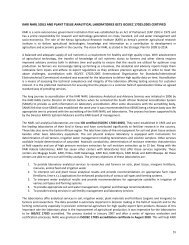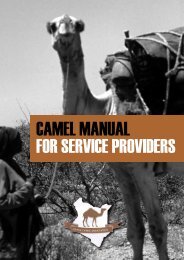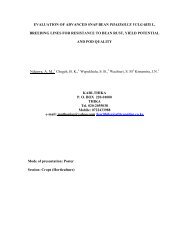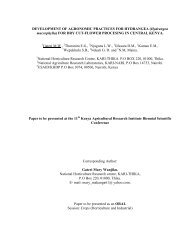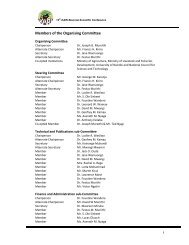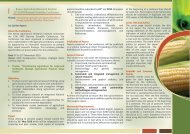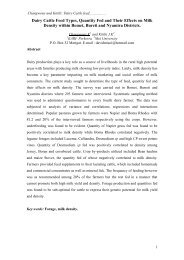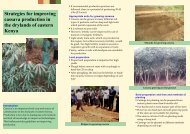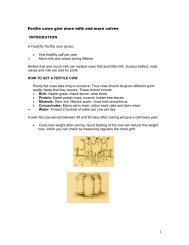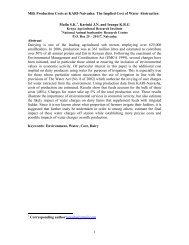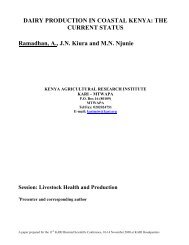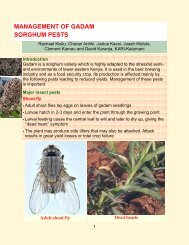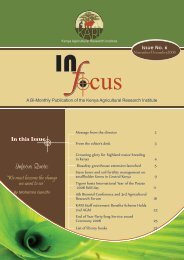January - June 2008 - Kenya Agricultural Research Institute
January - June 2008 - Kenya Agricultural Research Institute
January - June 2008 - Kenya Agricultural Research Institute
You also want an ePaper? Increase the reach of your titles
YUMPU automatically turns print PDFs into web optimized ePapers that Google loves.
Tips On Water Conservation - Every Drop Counts<br />
By Fabian Kaburu and Sijali Isaya V., KARI-Kabete<br />
<strong>Kenya</strong> is classified as a water-stressed country with<br />
an available renewable per capita water<br />
consumption of 650,000 litres per litre per year,<br />
which is way below the world average of 1,700,000 litres.<br />
With the country’s population growing at 2.3% per<br />
annum and socio-economic pursuits including<br />
urbanization, industrialisation, agricultural activity among<br />
others also growing, the demand for water has increased<br />
tremendously. <strong>Kenya</strong> experiences both extremes of<br />
weather vagaries. During the wet season, floods ravage<br />
many parts of the country, while in the dry season people<br />
experience famine due to drought. The latter is rapidly<br />
becoming a perennial problem.<br />
The graph shows the trend in discharge of the Ewaso<br />
Ngiro North river over the years – this trend is the same in<br />
other rivers.<br />
Every drop counts and should be conserved everywhere,<br />
at all times and by all to ensure efficient water use.<br />
Here are some recommended water saving practices:<br />
Indoors<br />
General<br />
Never pour water down the drain when there may be<br />
another use for it. Use it to water your indoor plants or<br />
garden.<br />
Make sure your home taps and pipes are leak-free. When<br />
you are certain that no water is being used in your home,<br />
take a reading of the water meter. Wait for 30 minutes and<br />
then take a second reading. If the meter reading changes,<br />
you have a leak!Repair dripping taps by replacing<br />
washers. One drop per second wastes 2,700 gallons<br />
(110,000 litres) of water per year!<br />
Bathroom<br />
• Check for toilet leaks by adding food colouring to the<br />
tank. If you have a leak, the colour will appear in the<br />
bowl within 30 minutes. (Flush immediately to avoid<br />
stains.)<br />
• If the toilet handle frequently sticks in the flush<br />
position letting water run constantly, replace or adjust<br />
it.<br />
• Leaky toilets usually can be fixed inexpensively by<br />
replacing the flapper.<br />
• Install a toilet displacement device to cut down on the<br />
amount of water needed for each flush. (Contrary to<br />
popular opinion, a brick should not be used because it<br />
can dissolve and the loose pieces can cause damage<br />
to the internal parts. Instead, place a one-gallon plastic<br />
jug of water into the tank to displace toilet flow or<br />
purchase a device available at most hardware and home<br />
centres designed for this purpose.) Be sure installation<br />
does not interfere with the operating parts.<br />
• Consider purchasing a low-volume toilet that uses less<br />
than half the water of older models.<br />
• Take shorter showers.<br />
• Replace your shower-head with an ultra-low-flow<br />
version.<br />
• Place a bucket in the shower to catch excess water for<br />
watering plants.<br />
• In the shower, turn the water on to get wet; turn off to<br />
lather up; then turn the water back on to rinse. Repeat<br />
when washing your hair.<br />
• Don’t let the water run while brushing your teeth,<br />
washing your face or shaving.<br />
• Avoid flushing the toilet unnecessarily. Dispose of<br />
tissues, insects, and other similar waste in the trash<br />
rather than the toilet.<br />
Kitchen<br />
• When hand washing dishes, save water by filling two<br />
containers - one with soapy water and the other with<br />
rinse water containing a small amount of chlorine<br />
bleach.<br />
• Most dishwashers can clean soiled dishes very well,<br />
so dishes do not have to be rinsed before washing.<br />
Just remove large particles of food, and put the soiled<br />
dishes in the dishwasher.<br />
• Store drinking water in the refrigerator. Don’t let the<br />
tap run while you are waiting for water to cool.<br />
• Clean vegetables in a pan filled with water rather than<br />
running water from the tap. Re-use the water that<br />
vegetables are washed in for cleaning or watering<br />
plants.<br />
• Kitchen sink disposals require lots of water to operate<br />
properly. Start a compost pit as an alternate method of<br />
disposing of food waste, or simply dispose of food in<br />
the garbage.<br />
Long Term Indoor Water Conservation<br />
• Consider installing an instant hot water heater on your<br />
sink<br />
• When purchasing a new appliance, choose one that is<br />
more energy and water efficient.<br />
Outdoors<br />
If you have a well or a borehole at home, check your pump<br />
periodically. If the pump turns on and off while water is<br />
not being used, you have a leak.<br />
Car Washing<br />
• If you wash your own car, park on the grass so that<br />
you will be watering it at the same time.<br />
Lawn Care<br />
• Don’t over water your lawn. Lawns only need to be<br />
watered every five to seven days in the dry season,<br />
and every 10 to 14 days in the wet season, if need be.<br />
A heavy rain eliminates the need for watering for up to<br />
two weeks. Most of the year, lawns only need one<br />
inch of water per week. Buy a rain gauge so that you<br />
can better determine when to water.<br />
Highlighter No. 23<br />
17



